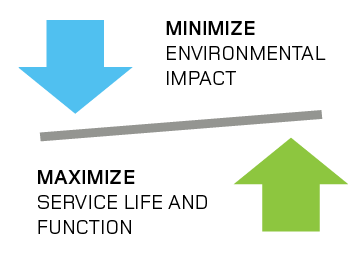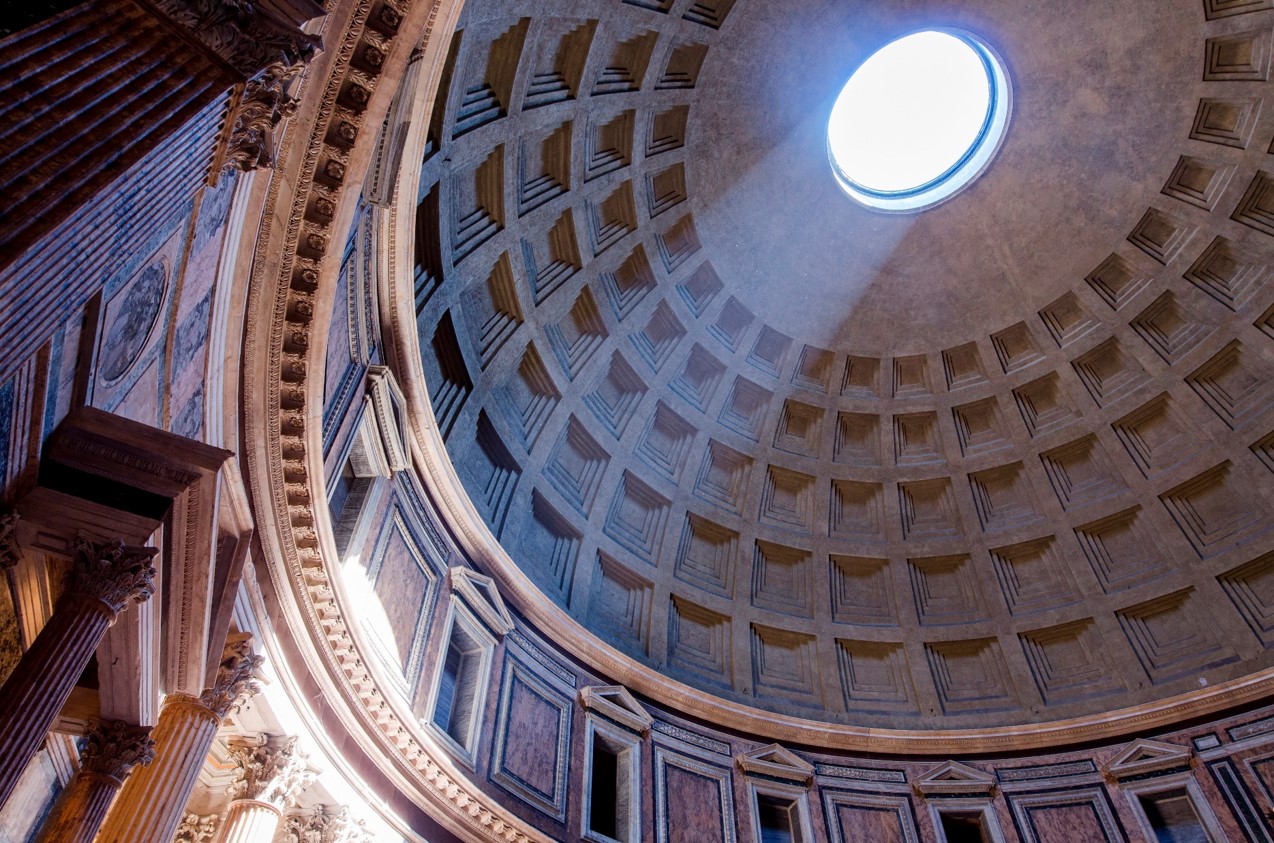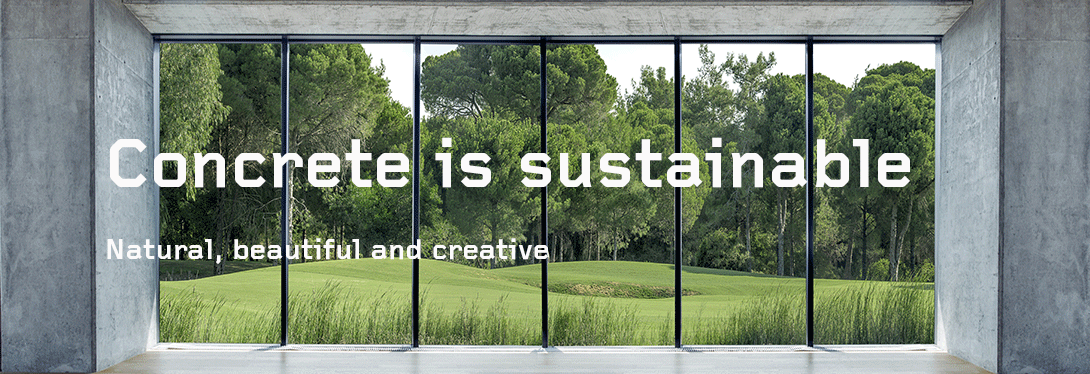Concrete is a sustainable material
Sustainability is about standing the test of time and balancing the three sustainability aspects: economy, environment, and social.
SUSTAINABILITY
|
Economy |
Environment |
Social |
Roads, bridges, tunnels, water treatment plants, power plants, homes, schools, hospitals, offices, etc., are necessary structures that are built every day and will continue to be built into the foreseeable future. However, building and maintaining those structures have an impact on the environment. All building materials have an environmental impact..
This is the classic dilemma between the social and economic sustainability aspects – meeting the need for housing, mobility, electricity and water supply, etc., – and the environmental aspects – use of resources and the impact on our environment, and climate and biodiversity, etc.
![]()
Sustainable construction calls to mind a design that is sustainable, i.e., able to withstand a certain load and use over time without breaking. It’s also about living in a way that does not deplete natural resources and does not destroy the climate and environment in the long run. In other words, sustainable construction is much more than just a question of robust materials and a solid design, although it is probably both economically and ecologically more advantageous to invest in buildings that will be used for many years than to demolish and build new ones at short intervals.”
There is and will always be a need for construction
The need for new housing and infrastructure is significant, not just globally, but also in Sweden.. According to the latest forecast from Boverket – the Swedish National Board of Housing, Building and Planning – Sweden will need 640,000 new homes during the ten-year period from 2018 to 2027, or about 64,000 new homes per year up to 2027.
At the same time, a number of major infrastructure projects such as the Stockholm Bypass, expansion of the Stockholm underground, the West Link in Gothenburg and the East Link between Gothenburg and Stockholm are all due to be completed.
Concrete is a prerequisite if all these projects are to achieve long-term sustainability.
Maximize and minimize
Sustainable construction is about maximizing the benefits, function and performance and minimizing the negative impact throughout the lifetime of a building.

The right material in the right place
Currently, there is a tendency for certain building material, timber, to be prescribed in a construction project. This practice limits the consideration of other materials and inhibits development.
Developers and regulators should set material-neutral requirements, allowing for material selection to center around the function and the life cycle of the structure. Material manufacturers will then continue to develop new, innovative, and climate-optimized products on an equal footing, leaving the market to choose the most suitable material. All materials have their advantages and disadvantages. The right material for a project is the material that effectively meets the needs of the structure and best contributes to long-term sustainable construction.
Assess and decide
The environmental impact of construction needs to be assessed on the basis of the function and performance of the building and from a life cycle perspective.
In order to determine whether a building material is sustainable, the economic, social and environmental aspects of the material over the lifetime of the building need to be evaluated and weighed.
Boverket's and Trafikverket's regulations set minimum requirements for function and performance. Developers and property owners often impose more stringent requirements that can complement the governing framework. These requirements can involve, for instance, strict demands on service life, fire protection and noise reduction.
To address these requirements, the following assessments can be used: Life Cycle Assessments (LCA) ![]() och olika Certification and Assessment Systems
och olika Certification and Assessment Systems ![]()
![]()
Concrete is a sustainable material
Concrete meets stringent sustainability requirements from a life cycle perspective. Concrete has many properties that are prerequisites for sustainable construction.
In its project Brf Viva in Gothenburg Riksbyggen has carried out life cycle assessments on different building materials and solutions. Based on these studies, Riksbyggen has actively chosen concrete as the material for the structural frame and has thus demonstrated that concrete is a sustainable material.
![]()
“It’s a great honor that Brf Viva has been named Environmental Building of the Year at the Sweden Green Building Awards. This win is proof of the work that Riksbyggen and all our partners have put in to create a unique housing project in which many solutions from the field of sustainability have been tested for the first time.”
Michael Ekberg, Regional Manager at Riksbyggenn ![]()
![]() READ MORE
READ MORE
När livslängd och underhåll räknas ![]()
Tidskriften Betong 4-18. Margareta Redlund Laninge.
Livscykeln – sanningen om stommaterialen. ![]()
Mellanrum 2017, Roger Andersson
Energi och klimateffektiva byggsystem Miljövärdering av olika stomalternativ. ![]()
SP 2015, Eva-Lotta Kurkinen, Joakim Norén, Diego Penaloza, Nadia Al-Ayish, Otto During
Klimagassregnskap av tre- og betongkonstruksjoner
Kontorbygning - 4, 8 og 16 etasjer. ![]()
Østfoldforskning 2019, Anne Rønning, Kjersti Prestrud, Lars G. F. Tellnes, Simon Saxegård, Simen S. Haave, Magne Lysberg
Minskad klimatpåverkan från flerbostadshus LCA av fem byggsystem. ![]()
Sveriges Byggindustrier 2018, Tove Malmqvist, Martin Erlandsson, Nicolas Francart, Johnny Kellner
Emission Omissions: Carbon accounting gaps in the built environment. ![]()
© 2019 International Institute for Sustainable Development
Seton Stiebert, Daniella Echeverría, Philip Gass, Lucy Kitson
Concrete is a durable material with a long life cycle. It requires minimal maintenance and can withstand the toughest challenges, including moisture, fire, noise, and extreme weather. Concrete has a high thermal inertia, which means that the temperature in a concrete building is stable, even when the outside temperature varies. The high density of concrete also means that heat loss is minimized. That results in low energy consumption, without the extra need for heating or cooling. This saves money and minimizes the impact on the environment over the lifetime of the building.
 Absorbs CO2
Absorbs CO2
Concrete does so spontaneously, throughout its entire lifetime, without impairment. Look around you, all exposed concrete you see absorbs CO2, and thereby helps to remove CO2 from our atmosphere. During the concrete life cycle up to 20 % of the CO2 emissions, is being absorbed back.
 100 % recyclable
100 % recyclable
Concrete is well adapted to a circular economy. Crushed concrete can be recycled as aggregates for newly produced concrete or be used as base layer in road constructions. In addition, crushed concrete absorbs even more CO2.
 Strong and durable
Strong and durable
Concrete has been used as a key construction material for thousands of years due to its durability and flexibility. Properly designed buildings last for a long time with a minimum need of maintenance, making concrete a sustainable construction material.
 Locally produced
Locally produced
Ready-mixed concrete is always produced locally, with locally sourced materials, leading to short transportation distances.
 Energy efficient
Energy efficient
Due to the thermal mass and airtight nature of concrete homes, the temperatures inside remain stable, despite the outdoor weather. Therefore, concrete buildings have low energy consumption which reduces the need of extra heating and cooling.
 Does not burn
Does not burn
Concrete is fire resistant. Concrete cannot be set on fire or emit toxic fumes during exposure to fire. Firemen and insurance companies agree that concrete is an optimal building material.
 Does not mold
Does not mold
Concrete is an inorganic and water resilient material. Meaning that it cannot mold or rot. Concrete is therefore not effected by water leakages and climate changes that may lead to increased frequency of flooding, storms and precipitation.
 Helps you sleep better
Helps you sleep better
The extraordinary sound insulating properties of concrete creates quiet and peaceful homes. You will be less bothered by disturbing traffic noise or your next-door neighbours.
 There are few building materials with properties that are as well documented as concrete, through both experience and long-term use.
There are few building materials with properties that are as well documented as concrete, through both experience and long-term use.
![]() READ MORE
READ MORE
CO2 uptake in cement containing products Background and calculation models for IPCC implementation. ![]()
Håkan Stripple Christer Ljungkrantz Tomas Gustafsson Ronny Andersson
Betong sparar energi. Betong — ett hållbart, lufttätt material som kan lagra energi och ger förutsättningar för energieffektiv drift ![]()
2015. Svensk Betong.
Trög betongstomme minskar energianvändningen och möjliggör fördröjning av effektuttag. ![]()
Anders Rönneblad, tekn lic, Cementa AB, Malmö, och Kajsa Byfors, projektledare, Svensk Betong, Stockholm. Bygg & teknik 7/12 53
Betong begränsar bränder. ![]()
Mars 2018. Svensk Betong
Betong uppfyller kraven för högsta brandsäkerhetsklass. ![]()
svenskbetong.se
Betong påverkas inte av fukt ![]()
svenskbetong.se
Betong ger god ljudmiljö inomhus. ![]()
Mars 2018. Svenska Betong
Concrete and carbon dioxide 
Although concrete has many properties that are prerequisites for sustainable construction, concrete also has an environmental impact. This is mainly due to emissions of carbon dioxide from the production of cement, which is one of the binders in concrete.
The concrete industry in Sweden is aiming to bring climate-neutral concrete to the market by 2030, and for all concrete in Sweden to be climate neutral by 2045. This work is progressing under the Swedish Concrete Initiative project. Read more at https://betonginitiativet.se ![]() .
.
![]()
Team Thomas is actively contributing to building a sustainable society.
Our ambition is to be an industry leader in providing sustainable products and services. We are working to reduce our environmental impact and increase the material’s service life, function, and performance. We are driving the development towards climate-neutral concrete.
We are The Concrete Specialists.





